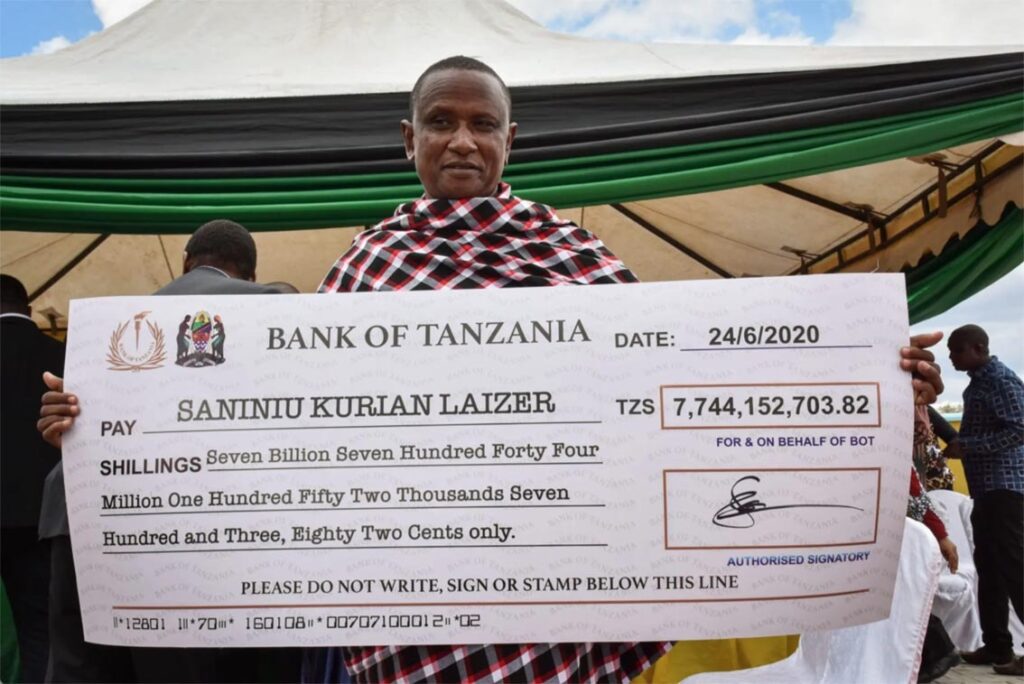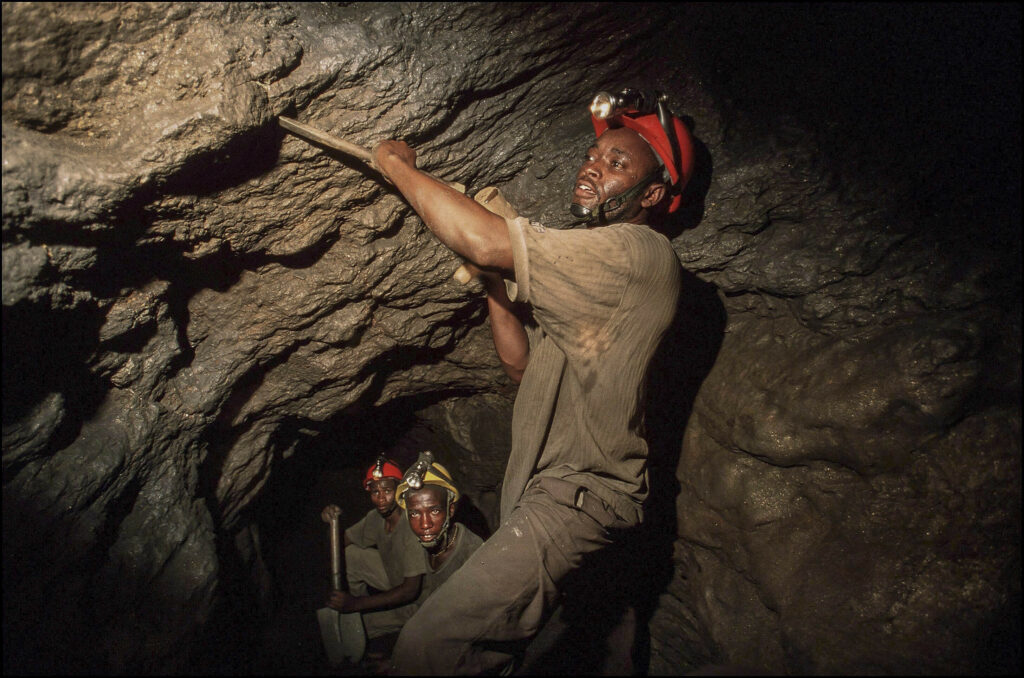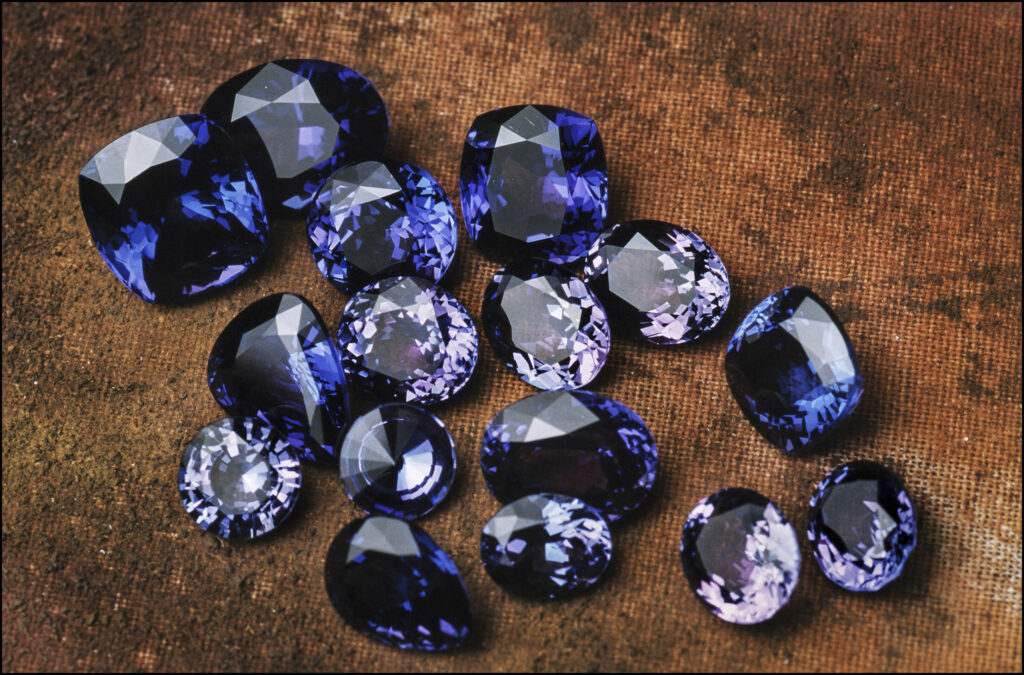Tanzanian small-scale miner Saniniu Kuryan Laizer, 52, poses with two of the biggest of the country's precious gemstones, Tanzanite, as a millionaire during the ceremony for his historical discovery in Manyara, northern Tanzania, on June 24, 2020. Laizer found the stones weighing 9.27 and 5.1 kilogrammes respectively in the northern Mirerani hills, an area which President John Magufuli had fenced off in 2018 to stop smuggling of the gem. He sold them to the government for 7.7 billion Tanzanian shillings (nearly $3.3 million/2.9 million euros). The broken biggest record of Tanzanite was 3.5 kilogrammes.
Filbert RWEYEMAMU / AFP
Lazaro Lasimi and his colleagues descended hundreds of metres into the earth underneath the Mererani Hills, in Manyara in northern Tanzania. At the bottom of the mine, they dug 57 small holes, carefully placing dynamite into each. Only when they were all safely on the surface did they press the trigger.
The explosion was designed to break the hard rock which protects one of the world’s most unique natural resources: tanzanite, the rare, shimmering violet-blue gem stone that is found only in Tanzania, and mostly in the Mererani Hills.
Usually, it takes 15 minutes for the dust to settle. That day, Lasimi remembers, something was different: it took half an hour, even with oxygen pipes lowered into the depths to speed up the process.
Once the staff geologist had given the go-ahead, Lasimi and the team eventually made it back down. In the rubble, he saw small and medium-sized rocks that he knew from seven years of experience in the mines here were likely to contain tanzanite. He started to collect them.
One of his colleagues spotted a huge black rock that had somehow survived the blast. He started bashing it with a hammer, trying to break it into smaller pieces. But this rock was stronger than the hammer. Suddenly he realised: this wasn’t ordinary rock; the whole thing was tanzanite.
 Tanzanian small-scale miner Saniniu Kuryan Laizer, 52, poses with the enlarged cheque copy from the government after selling two of the biggest of the country’s precious gemstones, Tanzanite, during the ceremony for his historical discovery in Manyara, northern Tanzania, on June 24, 2020. Laizer found the stones weighing 9.27 and 5.1 kilogrammes respectively in the northern Mirerani hills, an area which President John Magufuli had fenced off in 2018 to stop smuggling of the gem. He sold them to the government for 7.7 billion Tanzanian shillings (nearly $3.3 million/2.9 million euros). The broken biggest record of Tanzanite was 3.5 kilogrammes.
Filbert RWEYEMAMU / AFP
Tanzanian small-scale miner Saniniu Kuryan Laizer, 52, poses with the enlarged cheque copy from the government after selling two of the biggest of the country’s precious gemstones, Tanzanite, during the ceremony for his historical discovery in Manyara, northern Tanzania, on June 24, 2020. Laizer found the stones weighing 9.27 and 5.1 kilogrammes respectively in the northern Mirerani hills, an area which President John Magufuli had fenced off in 2018 to stop smuggling of the gem. He sold them to the government for 7.7 billion Tanzanian shillings (nearly $3.3 million/2.9 million euros). The broken biggest record of Tanzanite was 3.5 kilogrammes.
Filbert RWEYEMAMU / AFP
“Jamani, njooni muone maajabu, tumepata [Hurry, come and take a look],” he shouted. The miners crowded around him. The gemstone weighed an astonishing 9.27kg. Nobody at the mine that day had ever seen anything like it. Nobody anywhere had.
It was, by some margin, the largest tanzanite stone ever discovered. And its owner, Saniniu Laizer — who was not there that day, and was only informed later by his eldest son, Joseph — was about to become an American dollar millionaire, and a Tanzanian shilling billionaire, several times over.
“It was a surprise to all of us who were there that day. It was one of the happiest days in my life,” Lasimi said.
Riches-to-riches
Saniniu Laizer, 52, lives in a large compound in the village of Naisinyai. It’s in the foothills of Mount Kilimanjaro, not far from the Mererani mines, with a population of about 10 000 people. There are six large houses in the compound, which he shares with his four wives and 32 children.
Laizer is, by some distance, the richest man in the village — even before his record-breaking find. The family has farms and owns real estate and hotels in nearby Arusha. They own more than 2 000 head of cattle, and too many sheep and goats to count. Laizer also runs an extensive and relatively sophisticated tanzanite mining operation, employing hundreds of young men. This is not a rags-to-riches story; it is a riches-to-riches story.
 The Blue Diamond Of The Masai On January 6Th, 2002, Tanzania. In The Light Of Their Headlamps, Kneeling For Hours On End, The Miners Dig Using Chisels. They Fill Their Backs With Rubble Which They Hoist Upwards Using A Rope Pulled Up To The Surface. (Photo by Patrick AVENTURIER/Gamma-Rapho via Getty Images)
The Blue Diamond Of The Masai On January 6Th, 2002, Tanzania. In The Light Of Their Headlamps, Kneeling For Hours On End, The Miners Dig Using Chisels. They Fill Their Backs With Rubble Which They Hoist Upwards Using A Rope Pulled Up To The Surface. (Photo by Patrick AVENTURIER/Gamma-Rapho via Getty Images)
Laizer started his mining business 17 years ago with the proceeds from his cattle, according to his accountant and brother, Isaya. He began by finding small stones, which allowed him to invest in the machines needed to find bigger stones.
The family’s obvious prosperity is in stark contrast to the poverty of the village around their compound. Whereas the Laizers get water from their private borehole, the rest of the village relies on a few communal wells. In the dry season, when these run dry, people pay 1 000 shillings ($.50) for a bucket brought in by water tankers from Arusha.
There are two secondary and seven primary schools in the village, all government-run. According to Valentine Tesha, Naisinyai’s ward executive officer, this is not nearly enough to cater for the huge numbers of children in Naisinyai and the surrounding area. This means that, with the exception of the mines, employment opportunities are few and far between.
Laizer has little formal education; he cannot read or write — not that this has held him back. His success has made him something of a role model for youth in the village. The young men said he is jovial, kind-hearted and always available for a chat. More recently, after all the media attention, he’s been a little more difficult to pin down.
The big cheque
June 24 was a day that no one in Naisinyai will ever forget. The minister of mines, Dotto Biteko, arrived, along with his cavalcade. Journalists and cameras recorded everything. A makeshift stage was hastily erected, draped in the colours of Tanzania’s flag: green, yellow, black and blue.
The minister brought along an oversized cheque for the sum of 7.7 billion shillings ($3.3-million). In exchange, Laizer handed over his record-breaking 9.27kg tanzanite stone, along with another slightly smaller 5.1kg monster that had been found on the same day.
In a stilted address, Laizer, wrapped in his Maasai shuka, said: “I thank God for this achievement because it’s the first time to get this size. When I found these, I notified government officials who evaluated the stones and today they called me for payment.”
He said he plans to use the money to build a school and a clinic near his home, and a mall in Arusha. He will also give 10% to his employees.
With one eye on the general election on October 28, Biteko used the opportunity to praise Tanzania’s mining policies. “We Tanzanians have decided that minerals should first benefit us as a country,” he said. “We have had enough of selling our gems to others who benefit while our communities remain poor.”
Even President John Magufuli called in to offer his congratulations. “This is the benefit of small-scale miners and this proves that Tanzania is rich,” the president said.
As soon as the scale of Laizer’s windfall was made public, hundreds of people gathered outside his family’s compound, laying down their red-and-blue blankets on the ground outside. No one was invited, said Pakasi Mollel, Laizer’s brother-in-law, but since the Maasai are such a tight knit community most of the visitors were treated as relatives.
It was a festive, celebratory atmosphere. Over the course of more than a week, a 100 cows were slaughtered to feed the guests. “I have been here for days, chewing beef and meeting new and old friends, also rubbing shoulders with journalists holding their big cameras. I’m really enjoying it here, although I don’t have anything in my pocket – I’m hoping our big brother will open up and give me some money,” said Kalesi Lazaro, who said he was Laizer’s neighbour.
Tesha said the village was full of visitors from nearby rural areas who wanted to meet Laizer and ask for his financial assistance. “It was terrible here, almost all wanted money from him,” he said. Few understood that the big cheque was just for show, and the cash was not yet in Laizer’s account. Eventually, they left empty-handed, but with their stomachs full of smoked beef.
Hard work pays
Saniniu Laizer is, in the context of Naisinyai, unimaginably wealthy. But he might have been short-changed. “While the $3-million paid to the miner has undoubtedly changed his life forever, it is only a twentieth of the potential retail value of the gemstones he discovered,” Eddie LeVian, the chief executive of Le Vian jewellers, said in a statement. The company deals extensively in tanzanite.
Publicly, at least, Laizer does not appear to mind. “Selling to the government means there are no shortcuts … they are transparent,” he said in early August, on the occasion of another major find. This time, the tanzanite stone weighed 6.3kg, and he sold it to the government for another cheque made out for $2-million. This means the three largest tanzanite gemstones on record were all discovered by Laizer’s company.
 TANZANIA – JUNE 01: Tanzanite : The Blue Diamond Of The Masai On January 6Th, 2002, Tanzania. In Idar-Oberstein, Marco Ferreira’S Second Collection, Cut In Germany. The Best Of The Stones Will Sell For Prices Ranging From 400 To 1,500 Dollars Per Carat. (Photo by Patrick AVENTURIER/Gamma-Rapho via Getty Images)
TANZANIA – JUNE 01: Tanzanite : The Blue Diamond Of The Masai On January 6Th, 2002, Tanzania. In Idar-Oberstein, Marco Ferreira’S Second Collection, Cut In Germany. The Best Of The Stones Will Sell For Prices Ranging From 400 To 1,500 Dollars Per Carat. (Photo by Patrick AVENTURIER/Gamma-Rapho via Getty Images)
“I have nothing to complain about at all,” he said. “Hard work pays.”
This story was first published in The Continent, the weekly pan-African newspaper. Download your free copy here